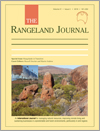
The Rangeland Journal
Volume 41 Number 3 2019
Rangelands in Transition
Seasonal climate forecasts have the potential to improve profitability in agricultural industries. This study investigates the value of forecasts at various skill levels for a grazing enterprise in northern Australia and shows that even current forecast skill levels of around 60% accuracy offer economic value. An explicit integrated bio-economic framework which demonstrates the value of seasonal climate forecasts at both current and improved skill levels, as developed in this study, could increase confidence in the use of forecasts in agricultural decision making, reducing climate risk and enhancing productivity and profitability.
RJ18017Social return on investment: application for an Indigenous rangelands context
Ongoing government investment in natural resource management is tenuous and diversified investment partnerships must be considered if we wish to maintain or increase service delivery in areas of need. Our research in the Anangu Pitjantjatjara Yankunytjatjara Lands found that feral herbivores present a net cost impact to society of ~$4 million per year. A Social Return on Investment approach identified the creation of $3 social return for every $1 invested in feral herbivore control programs. An Social Return on Investment approach to program investment can deliver leveraged and ongoing public and private good benefits in Indigenous rangelands.
RJ18022Ninety years of change on the TGB Osborn Vegetation Reserve, Koonamore: a unique research opportunity
This Reserve, the oldest of its kind in Australia, has protected a badly overgrazed area from stock grazing for over 90 years. Plants have been mapped and measured in quadrats and photo-points over that time to record changes. The data provide a wealth of information for further ecological research.
RJ18023An uncertain future: climate resilience of first-generation ranchers
Ensuring the next generation of ranchers are resilient to climate extremes is a central challenge in building the sustainability of rangeland socioecological systems. A survey of hundreds of cattle ranchers in California, USA, revealed first-generation producers are less connected, have fewer resources, and are thus more vulnerable to climate change than traditional multigenerational ranchers. Research, outreach, and technical support organisations must address the management decision–making information needs of this emerging stakeholder base to sustain these ecosystems and their dependent rural communities.
Land degradation and climate change are contested concepts, with global-scale expert views often diverging from local landholder perspectives. This study finds that the culture of adaptation displayed by rangeland communities provides a strong basis for responding to these challenges, even if their impacts fall outside the lived experience of such communities. Expert and scientific knowledge needs to build upon, and be integrated with, local knowledge, perspectives and cultures of adaptation rather than being seen as a substitute.
RJ18032Evaluating the potential financial contributions of carbon farming to grazing enterprises in Western NSW
Payments to landholders for sequestering carbon could have substantial long-term effects on farm and regional incomes and land management requirements. This study evaluates the short to long-term financial outcomes of such ‘carbon farming’ for grazing enterprises in north-western New South Wales, Australia. Our results suggest that carbon farming could increase net incomes but outcomes are sensitive to land and vegetation types and influenced by how the additional income is used.
RJ18036Long Paddock: climate risk and grazing information for Australian rangelands and grazing communities
The Long Paddock website has been redeveloped to provide Australian rangelands and grazing communities with easy-to-access seasonal climate and pasture condition information. Current, historical and seasonal forecast information and services are available online to support management decisions to maximise productivity, while maintaining the natural resource base in a highly variable climate. View the ‘Australia’s variable rainfall’ poster (128-year maps); the ‘Queensland’s extended wet and dry periods’ poster; and the new rainfall poster ‘Map App’ visualisation.
RJ18036 Abstract | RJ18036 Full Text | RJ18036PDF (846 KB) Open Access Article
RJ18047Looking beyond the D.U.S.T. – building resilient rangeland communities
Towns and small businesses are vital to the long-term viability of rangeland communities, yet information on their economic and social contribution is sparse. Drought in central western Queensland has led to severe economic decline, population loss and weakening of social cohesion in the towns. A framework with the acronym D.U.S.T was developed as part of a case study in this region, to promote adaptability, equity and inclusiveness. D.U.S.T. encourages policy makers to Decide to act; Understand the complex socioeconomic interrelationships; Support local capacity; and Transform governance arrangements when developing strategies to build resilience in remote rural and rangeland communities facing adversity.
RJ18052Overcoming drought vulnerability in rangeland communities: lessons from central-western Queensland
Resilience is the key to the survival of drought-vulnerable communities, but can it be strengthened? The people of central-western Queensland rallied during the extended 2012–19 drought by advocating for collaborative action. They linked with external groups and engaged government at multiple levels for support and investment to reduce drought vulnerability and build resilience. Their success demonstrates that the economy and communities can be strengthened by learning and adapting during drought, especially by ensuring drought relief focuses on whole communities.
RJ18105Australian rangeland futures: time now for systemic responses to interconnected challenges
 , Mark Stafford Smith, Don Burnside, Martin Andrew, Don Blesing, Kate Forrest and John Taylor
, Mark Stafford Smith, Don Burnside, Martin Andrew, Don Blesing, Kate Forrest and John Taylor
Despite rapid technology improvements that shrink the world and speed it up, Australia’s rangelands – which constitute about 80% of its landmass – are becoming effectively more remote and more complex to manage. Livelihoods that sustain communities, landscapes and biodiversity will need to retain long-term Indigenous, ecological and industry knowledge, in a context of changing demographics, opportunities and threats from new technologies, increasing global pressures, as well as evolving urban and market expectations. Policies, which are often developed at a distance from the rangelands, must avoid patchwork solutions and build the capacity of regional and remote communities to respond.
RJ18105 Abstract | RJ18105 Full Text | RJ18105PDF (983 KB) Open Access Article



